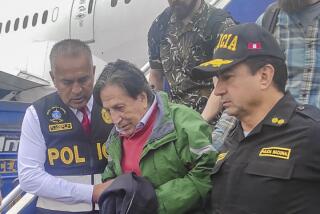Body of Marcos Back Home in Philippines
- Share via
LAOAG, Philippines — Seven years ago, Ferdinand E. Marcos was forced to flee for his life from his presidential palace in Manila as the Philippines’ “people power” uprising ended his 20-year rule, marked by corruption and abuse.
Today, the body of the man who died in exile in 1989--and is now considered by many to have been one of history’s greatest plunderers--returned home for a long-delayed funeral and a hero’s welcome from thousands of still-faithful supporters in his native province.
After having lain in a refrigerated coffin inside an air-conditioned crypt in Hawaii for the past four years, the deteriorating corpse is to be kept in a sealed casket for a series of rituals and ceremonies here before eventually being installed in a specially built mausoleum in his hometown of Batac.
There, according to his family and his mortician, the remains of the late president are to be put on public display in a glass coffin that resembles a large aquarium.
The bizarre and somewhat macabre homecoming is intended by the Marcos family to be a symbol of reconciliation between supporters of the autocrat and those who deposed him in 1986, including the current president, Fidel V. Ramos. But in many ways, the return serves to underscore regional divisions and Philippine fractiousness, not only between rival political groups but also inside the Marcos loyalist camp and even within the late president’s family.
“I’m asking the Filipino people to pray for a miracle, that President Ramos takes this occasion to unite with his cousin,” said Marcos’ widow, Imelda Marcos, as she left a meeting at the governor’s office in this northern Philippine province of Ilocos Norte on Monday.
Ramos, a former general who helped Corazon Aquino oust Marcos in 1986, is a second cousin of the late president, under whom he rose to the post of acting armed forces chief of staff. He was elected to succeed Aquino last year.
Aquino and her supporters blame Marcos for the 1983 assassination of her husband, opposition leader Benigno S. Aquino Jr., and for plunging the country into poverty and debt during what critics called a 20-year “kleptocracy” marked by the systematic plundering of the national treasury. Estimates of the amount of public money Marcos and his wife took for their own use are as high as more than $5 billion, enough to gain them a place in the Guinness Book of World Records as among history’s greatest thieves.
Ramos lifted Aquino’s ban on the repatriation of Marcos’ body, but he has continued to object to giving the former dictator a state funeral or burying him in Manila, as the Marcos family desires. Nor has he acceded to Imelda Marcos’ pleas that he at least attend her husband’s funeral, scheduled for Friday in Batac.
After arriving aboard a special flight from Guam, Marcos’ black-lacquered, gold-handled casket was placed on a platform at the airport amid singing, dancing and a variety of rites. Among them were ritual wailing and a ceremony called banga , in which Ilocanos break black earthen pots to drive away evil spirits.
The casket then was carried on a horse-drawn caisson with military honors to St. William Cathedral here for a Mass and moved to a stage in front of the governor’s office, to be displayed overnight.
More to Read
Sign up for Essential California
The most important California stories and recommendations in your inbox every morning.
You may occasionally receive promotional content from the Los Angeles Times.













